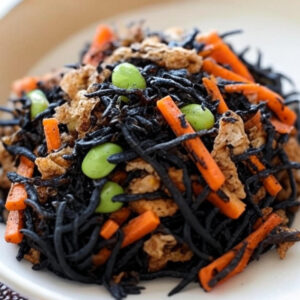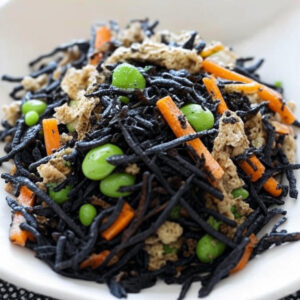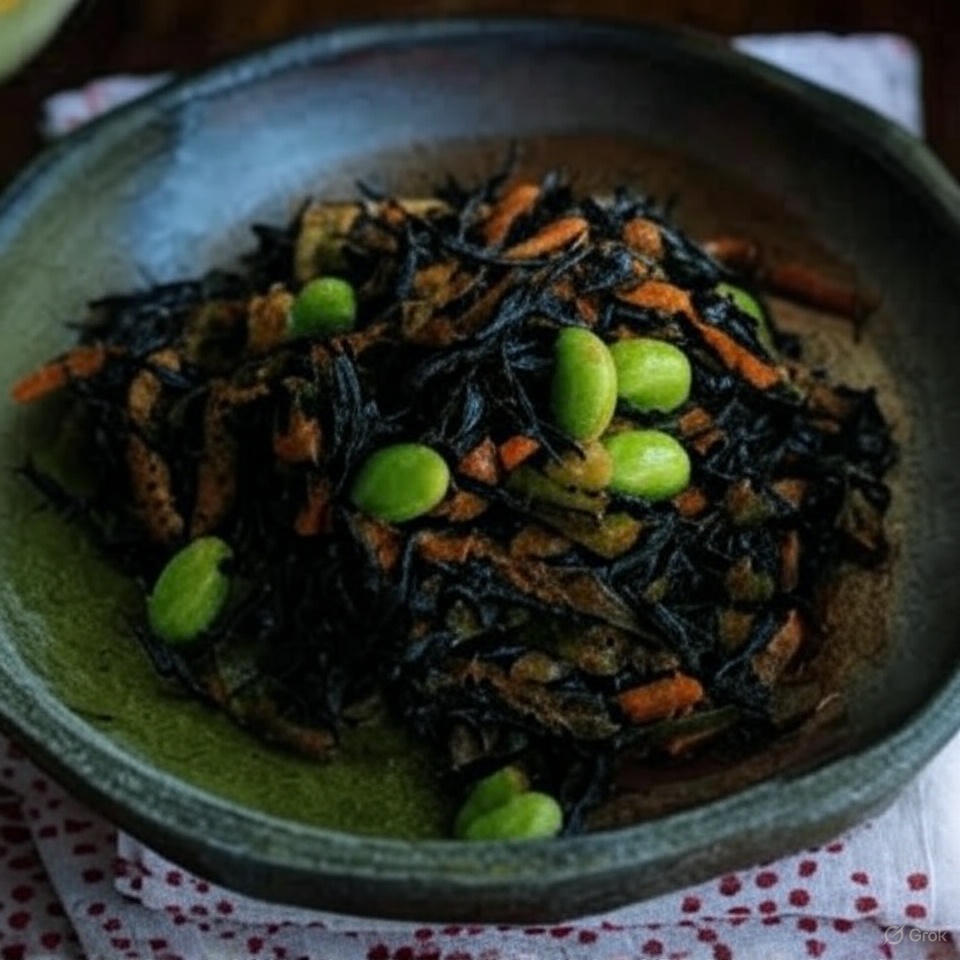Hijiki Seaweed Salad, often referred to as Hijiki no Nimono in Japanese, is a classic simmered dish rather than a salad in the Western sense. While it may be labeled as a “salad” for better global recognition, this hearty and nutritious recipe is typically served at room temperature and makes a wonderful side dish. It’s also a favorite addition to Japanese bento boxes due to its ability to stay fresh for several days.
Table of Contents
What is Hijiki no Nimono?
In Japanese cuisine, nimono (煮物) refers to dishes that are simmered in a seasoned broth. Hijiki no Nimono combines rehydrated hijiki seaweed with vegetables such as carrots, aburaage (deep-fried tofu), and often edamame beans. The ingredients are simmered gently in a flavorful mix of dashi, soy sauce, sugar, and sake, creating a savory-sweet umami taste that’s both comforting and deeply satisfying.

Is Hijiki Safe to Eat?
Hijiki seaweed is rich in dietary fiber, calcium, iron, and essential minerals. It’s been a staple in Japanese households for centuries, and there’s even a saying: “Those who eat hijiki live long lives.”
However, it’s important to note that hijiki contains small amounts of inorganic arsenic, which has led some Western countries—like Australia—to restrict its commercial sale. Despite this, food safety authorities in Japan emphasize that the average hijiki intake in a Japanese diet is well below dangerous levels. Occasional consumption, especially in moderation, is not considered hazardous by many health experts.
If you’re outside of Australia or countries with strict restrictions, hijiki can often be found in Japanese grocery stores or purchased online. For Australians, bringing hijiki from overseas for personal use is permitted.
Why Is Hijiki Seaweed Salad Popular?
Hijiki seaweed salad is a favorite make-ahead side dish in Japanese households. It can be stored in the refrigerator for 3–4 days and retains its taste and texture well. Its versatility, earthy umami flavor, and ability to complement a variety of meals make it a beloved companion to rice dishes, miso soup, and grilled proteins.
Ingredients for Hijiki Seaweed Salad
Here’s what you need to prepare a batch of hijiki no nimono that serves 4 people:
-
20g (0.7 oz) dried hijiki seaweed (soaked in 1L water for 1 hour)
-
2 sheets aburaage (fried thin tofu)
-
80g (2.8 oz) carrot, cut into matchsticks (~3cm long, 3mm wide)
-
40g (1.4 oz) frozen edamame beans
-
2 tbsp sesame oil
Flavouring Broth:
-
150ml dashi stock
-
2 tbsp soy sauce
-
1.5 tbsp sugar
-
1 tbsp sake
Step-by-Step Cooking Instructions
-
Prepare the Hijiki: Soak the dried hijiki in 1 liter of water for an hour. After soaking, rinse it several times and drain thoroughly.
-
Handle the Aburaage: To remove excess oil, pour hot water over the aburaage sheets, squeeze out moisture, then cut them in half lengthwise and slice crosswise into 5mm strips.
-
Cook the Edamame: Boil frozen edamame for 2–3 minutes, then drain and set aside.
-
Sauté the Ingredients: Heat sesame oil in a pan over high heat. Sauté the carrot for 30 seconds, then add hijiki and stir-fry for another 30–60 seconds. Add aburaage and continue sautéing for 30 more seconds.
-
Simmer in Broth: Add the dashi, soy sauce, sugar, and sake. Reduce the heat to medium and simmer for 7–8 minutes, stirring occasionally, until most of the liquid evaporates.
-
Finish and Serve: Stir in the edamame, turn off the heat, and serve either in a communal bowl or in small individual dishes.

Customizing Your Hijiki Salad
You can customize this salad based on seasonal availability or preference:
-
Add lotus root, boiled soybeans, or konnyaku for variation.
-
Use green beans or snow peas instead of edamame for a pop of color.
-
Cut vegetables in your preferred shapes – sticks, slices, or cubes – as long as sizes are consistent.
Storage and Freezing Tips
-
Refrigerate: Store in an airtight container for up to 4 days.
-
Freeze: For longer storage, freeze the salad without excess liquid. Avoid adding konnyaku if freezing, as it does not hold up well after thawing.
Nutritional Benefits of Hijiki
Hijiki is not only flavorful but also packed with nutrition. It’s an excellent source of:
-
Dietary fiber
-
Calcium
-
Iron
-
Magnesium
-
Iodine
Traditionally, hijiki has been associated with health benefits such as promoting long life and even maintaining hair color. Some believe that regular consumption of hijiki helps prevent premature graying of hair—a belief that has endured through generations.
Frequently Asked Questions
Q1: Is hijiki safe for children?
Yes, in small amounts. Japanese children regularly eat hijiki as part of their diet. However, moderation is key.
Q2: Can I use canned hijiki instead of dried?
Dried hijiki is preferred for this dish. If using canned hijiki, reduce the soaking step and check the sodium levels.
Q3: Can I replace aburaage with something else?
Yes, firm tofu or tempeh can be used as alternatives, although they’ll have different textures.
Q4: What’s the best way to reheat hijiki salad?
Hijiki salad is best served at room temperature. However, you can briefly microwave it or steam lightly if preferred warm.
Final Thoughts
Hijiki no Nimono, or hijiki seaweed salad, is a gem of Japanese home cooking—nutritious, flavorful, and easy to prepare ahead. Despite concerns over arsenic content, enjoying hijiki occasionally and in moderation is considered safe and health-supportive by many nutritionists and cultural experts. Its versatility and health benefits make it a must-try addition to your culinary repertoire, especially if you’re exploring authentic Japanese flavors.
So the next time you want a delicious and nutrient-rich side dish, give this traditional hijiki seaweed salad a go!

